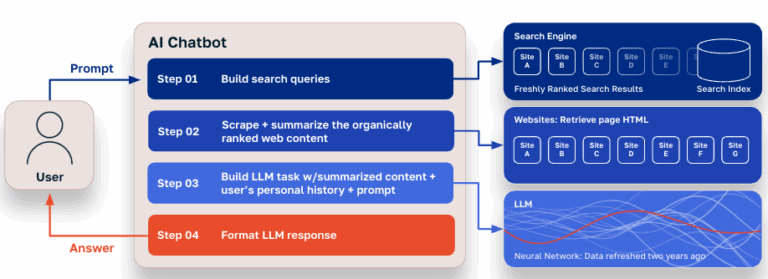We Just Hosted Our Most-Attended Webinar Yet
Last week, I had the pleasure of hosting a webinar on Generative Engine Optimization (GEO). It turned out to be the most well-attended session in Walker Sands history by a wide margin.
That level of engagement speaks to the urgency B2B marketers feel right now. Generative AI is fundamentally reshaping brand discovery — and marketers know they need to be ready.
For those who couldn’t join us live, here’s a quick recap of the highlights and key takeaways.
How GEO Works in Practice
At the beginning of the webinar, we broke down how generative engines construct responses. Understanding that process is a critical step for marketers aiming to understand where and how they can influence outcomes.
Here’s what’s happening behind the scenes when someone asks ChatGPT, Claude or another AI chatbot a question:
- Training data – LLMs are built on massive datasets pulled from brands’ web content, aggregators, review platforms, earned media and offline materials. But those datasets are often many months or even years out of date. That means fresh content isn’t immediately part of the model’s “memory.”
- Grounding data – To incorporate fresh data, generative engines ground their response in publicly available web page content that is surfaced from highly ranked organic search results. They build prompt-relevant search queries, send it to a search engine, retrieve ranked search results, scrape the content and then summarize it.
- Answer generation – The model then blends what it knows from training data with what it just pulled from search (plus any relevant information from prior conversations with the user) to generate a grounded response.

In practice, GEO is about ensuring your brand is included in those generated responses and represented accurately. Since generative engines pull from both historical training data and live search, your presence (or absence) in those sources directly shapes how your brand is positioned in the answers buyers see.
Beyond the Basics: 8 Strategic GEO Opportunities
A basic understanding of what’s happening behind the scenes is useful information. But the obvious next questions are, ”What can I do about it? And how can I start influencing GenAI responses today?”
During the webinar we shared eight discrete actions marketers can take to improve brand visibility and perception across a variety of generative environments.
If completed comprehensively, these actions maximize the opportunity for visibility. But any combination of these actions will produce incremental gains, so don’t feel pressured to do them all right away.
- Visibility + perception gap analysis – Benchmark how your brand shows up and is perceived in AI responses compared to competitors.
- Persona-based research – Use persona-driven prompts to uncover topics that are highly relevant to your target personas. An example prompt might be: “You are a seasoned CTO at a Fortune 500 healthcare company located in the United States. You are looking for a cybersecurity partner. Identify and rank the criteria used to evaluate potential partners.” This research should surface a robust list of topics and questions to fuel your content strategy.
- Content optimization – Structure content with summaries, tables of contents, schema, bullets, media, FAQs and topical depth so it’s both AI- and human-friendly.
- Authorship and authority – Demonstrate expertise across owned content with strong author pages to build trust signals.
- Technical optimization – Ensure your site architecture, load speed and markup help AI engines see and interpret your content.
- Channel diversification – Ensure your brand appears in the broader web ecosystem AI draws from.
- Earned media amplification – Secure mentions and citations in trusted third-party sources.
- Measurement – Track how and where your brand shows up in generative responses over time.
Each of these actions will help you improve how your brand is discovered in the age of GenAI.
My Three Big GEO Takeaways
If I had to distill our 60-minute webinar into three key takeaways, they’d be:
- GEO is not an isolated discipline or one person’s job. It cuts across every aspect of marketing. Success in GEO requires collaboration across content, SEO, PR, demand generation and web development teams. It’s not a one-off tactic but an organizational shift in how you think about brand visibility. From earned media to technical optimization, every marketing function contributes to how generative AI perceives and presents your brand.
- SEO is not dead — far from it. It’s a foundational building block for GEO. Despite the hype around generative AI, traditional SEO remains the bedrock of visibility. Search rankings still dictate which content AI Chatbots pull into their grounding process. If your site doesn’t rank well in organic search, in many cases, GenAI has little chance of surfacing your brand in its responses. GEO builds on SEO, it doesn’t replace it.
- Fresh, timely content (following the tips for optimization) is critically important. Because LLM training data often lags (sometimes years behind) the only way to influence current responses is through fresh, optimized content that shows up in live search. Structured pages, rich schema, FAQs, transcripts and authoritative authorship all help ensure your content is readable by both humans and AI systems. The more timely and complete your content is, the more likely it will be cited and recommended in real buyer conversations.
Watch the Full Webinar
These highlights just scratch the surface of what we covered. If you want to dig deeper into the frameworks and examples we walked through, you can catch the full webinar on demand here. I hope you find it useful as you plan out your GEO roadmap!



